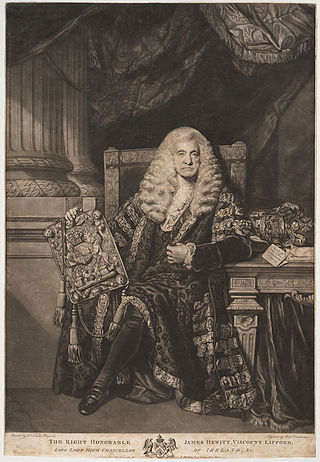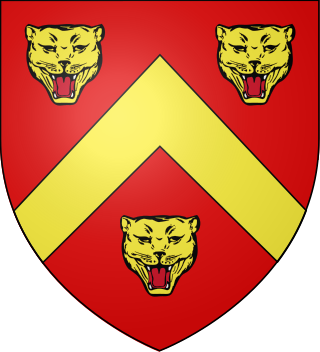
Earl of Cork is a title in the Peerage of Ireland, held in conjunction with the Earldom of Orrery since 1753. It was created in 1620 for Richard Boyle, 1st Baron Boyle. He had already been created Lord Boyle, Baron of Youghal, in the County of Cork, in 1616, and was made Viscount of Dungarvan, in the County of Waterford, at the same time he was given the earldom. These titles are also in the Peerage of Ireland.

Earl of Shrewsbury is a hereditary title of nobility created twice in the Peerage of England. The second earldom dates to 1442. The holder of the Earldom of Shrewsbury also holds the title of Earl of Waterford (1446) in the Peerage of Ireland and Earl Talbot (1784) in the Peerage of Great Britain. Shrewsbury and Waterford are the oldest earldoms in their peerages held by someone with no higher title, and as such the Earl of Shrewsbury is sometimes described as the premier earl of England and Ireland.

Earl of Suffolk is a title which has been created four times in the Peerage of England. The first creation, in tandem with the creation of the title of Earl of Norfolk, came before 1069 in favour of Ralph the Staller; but the title was forfeited by his heir, Ralph de Guader, in 1074. The second creation came in 1337 in favour of Robert de Ufford; the title became extinct on the death of his son, the second Earl, in 1382. The third creation came in 1385 in favour of Michael de la Pole. The fourth creation was in 1603 for Lord Thomas Howard, the second son of Thomas Howard, 4th Duke of Norfolk, by his second wife Margaret Audley, the daughter and eventual sole heiress of Thomas Audley, 1st Baron Audley of Walden, of Audley End in the parish of Saffron Walden in Essex. Howard was a prominent naval commander and politician and served as Earl Marshal, as Lord Chamberlain of the Household and as Lord High Treasurer. In 1597 he was summoned to Parliament as Baron Howard de Walden, and in 1603 he was further honoured, at the start of the reign of King James I, when he was created Earl of Suffolk. His second son the Hon. Thomas Howard was created Earl of Berkshire in 1626.

Earl of Abingdon is a title in the Peerage of England. It was created on 30 November 1682 for James Bertie, 5th Baron Norreys of Rycote. He was the eldest son of Montagu Bertie, 2nd Earl of Lindsey by his second marriage to Bridget, 4th Baroness Norreys de Rycote, and the younger half-brother of Robert Bertie, 3rd Earl of Lindsey. His mother's family descended from Sir Henry Norris, who represented Berkshire and Oxfordshire in the House of Commons and served as Ambassador to France. In 1572 he was summoned by writ to Parliament as Lord Norreys de Rycote. He was succeeded by his grandson, the second Baron. In 1621, he created Viscount Thame and Earl of Berkshire in the Peerage of England. He had no sons and on his death in 1624 the viscountcy and earldom became extinct. He was succeeded in the barony by his daughter Elizabeth, the third holder of the title. On her death, the title passed to her daughter, the aforementioned Bridget, the fourth Baroness, and second wife of the second Earl of Lindsey.

Earl of Carlisle is a title that has been created three times in the Peerage of England.

Marquess Townshend is a title in the Peerage of Great Britain held by the Townshend family of Raynham Hall in Norfolk. The title was created in 1787 for George Townshend, 4th Viscount Townshend.

Marquess of Linlithgow, in the County of Linlithgow or West Lothian, is a title in the Peerage of the United Kingdom. It was created on 23 October 1902 for John Hope, 7th Earl of Hopetoun. The current holder of the title is Adrian Hope.

Earl of Coventry is a title that has been created twice in the Peerage of England. The first creation for the Villiers family was created in 1623 and took its name from the city of Coventry. It became extinct in 1687. A decade later, the second creation was for the Coventry family and is still extant.

Earl of Scarbrough is a title in the Peerage of England. It was created in 1690 for Richard Lumley, 2nd Viscount Lumley. He is best remembered as one of the Immortal Seven who invited William of Orange to invade England and depose his father-in-law James II. Lumley had already been created Baron Lumley, of Lumley Castle in the County of Durham, in 1681, and Viscount Lumley, of Lumley Castle in the County of Durham, in 1689. These titles are also in the Peerage of England. The title of Viscount Lumley, of Waterford, was created in the Peerage of Ireland in 1628 for his grandfather Sir Richard Lumley, who later fought as a Royalist in the Civil War.

Earl of Jersey, is a title in the Peerage of England. It is held by a branch of the Villiers family, which since 1819 has been the Child Villiers family.

Earl Ferrers is a title in the Peerage of Great Britain. It was created in 1711 for Robert Shirley, 14th Baron Ferrers of Chartley. The Shirley family descends from George Shirley of Astwell Castle, Northamptonshire. In 1611 he was created a Baronet, of Staunton Harold in the County of Leicester, in the Baronetage of England. He was succeeded by his son Henry, the second Baronet, who married Lady Dorothy Devereux, daughter of Robert Devereux, 2nd Earl of Essex. On the death of her brother Robert Devereux, 3rd Earl of Essex, she became the youngest co-heir to the baronies of Ferrers of Chartley and the barony of Bourchier, which had fallen into abeyance on the death of the third Earl. Shirley was succeeded by his eldest son, the third Baronet. He died unmarried and was succeeded by his younger brother, the fourth Baronet. He was imprisoned in the Tower of London by Oliver Cromwell and died there in 1656. On his death the title passed to his eldest son, the fifth Baronet. He died at an early age and was succeeded at birth by his posthumous son, the sixth Baronet.

Earl Howe is a title that has been created twice in British history, for members of the Howe and Curzon-Howe family respectively. The first creation, in the Peerage of Great Britain, was in 1788 for Richard Howe, 4th Viscount Howe, but it became extinct upon his death in 1799. The second creation, in the Peerage of the United Kingdom, was in 1821 for Richard Curzon-Howe, 2nd Viscount Curzon, and it remains extant.

Viscount Charlemont is a title in the Peerage of Ireland. It was created in 1665 for William Caulfeild, 5th Baron Charlemont.

Viscount Lifford is a title in the Peerage of Ireland. It was created in 1781 for James Hewitt, 1st Baron Lifford, the Lord Chancellor of Ireland. He had already been created Baron Lifford, of Lifford in the County of Donegal, in 1768, also in the Peerage of Ireland. He was succeeded by his son, the second Viscount, who was Dean of Armagh from 1796 to 1830. His grandson, the fourth Viscount, sat in the House of Lords as an Irish representative peer from 1856 to 1887. His younger son, the sixth Viscount, was a captain in the Royal Navy. His son, the seventh Viscount, fought in both the Second Boer War and the First World War. He was succeeded by his cousin, the eighth Viscount. He was the son of the Hon. George Wyldbore Hewitt, seventh son of the fourth Viscount. As of 2014 the titles are held by his son, the ninth Viscount, who succeeded in 1987.

Baron Feversham is a title that has been created twice, once in the Peerage of Great Britain and once in the Peerage of the United Kingdom. The first creation, in the Peerage of Great Britain, came in 1747 when Anthony Duncombe, who had earlier represented Salisbury and Downton in the House of Commons, was made Lord Feversham, Baron of Downton, in the County of Wilts. He had previously inherited half of the enormous fortune of his uncle Sir Charles Duncombe. However, Lord Feversham had no sons and the barony became extinct on his death in 1763. The peerage was revived in the Peerage of the United Kingdom in 1826 in favour of his kinsman Charles Duncombe, who was created Baron Feversham, of Duncombe Park in the County of York. He was a former Member of Parliament for Shaftesbury, Aldborough, Heytesbury and Newport. Duncombe was the grandson of Thomas Duncombe, son of John Brown by his wife Ursula Duncombe, aunt of the first Baron of the 1747 creation. Ursula had inherited the other half of her brother Sir Charles Duncombe's fortune. Lord Feversham son, the second Baron, sat as a Conservative Member of Parliament for Yorkshire and the North Riding of Yorkshire.

Earl of Munster is a title that was created twice, once in the Peerage of Ireland and once in the Peerage of the United Kingdom. The first creation came in 1789 in favour of Prince William, the third son of King George III. He was made Duke of Clarence and St Andrews at the same time. When William succeeded to the throne as King William IV in 1830 the titles merged with the crown.

Earl Stanhope was a title in the Peerage of Great Britain. The earldom was created in 1718 for Major General James Stanhope, a principal minister of King George I, with remainder to the heirs male of his body. He was the son of the Hon. Alexander Stanhope, fifth and youngest son of Philip Stanhope, 1st Earl of Chesterfield. In 1717, James Stanhope had been raised to the peerage as Viscount Stanhope, of Mahón in the Island of Minorca, and Baron Stanhope, of Elvaston in the County of Derby, with special remainder, failing heirs male of his body, to his second cousin John Stanhope of Elvaston and the heirs male of his body. These titles were also in the Peerage of Great Britain. The heir apparent of the Earls Stanhope used Viscount Mahon as a courtesy title.

Earl Cowper was a title in the Peerage of Great Britain. It was created in 1718 by George I for William Cowper, 1st Baron Cowper, his first Lord Chancellor, with remainder in default of male issue of his own to his younger brother, Spencer Cowper. Cowper had already been created Baron Cowper of Wingham in the County of Kent, in the Peerage of England on 14 December 1706, with normal remainder to the heirs male of his body, and was made Viscount Fordwich, in the County of Kent, at the same time as he was given the earldom, also Peerage of Great Britain and with similar remainder. He was the great-grandson of William Cowper, who was created a Baronet, of Ratling Court in the County of Kent, in the Baronetage of England on 4 March 1642. The latter was succeeded by his grandson, the second Baronet. He represented Hertford in Parliament. He was succeeded by his eldest son, the aforementioned William Cowper, the third Baronet, who was elevated to the peerage as Baron Cowper in 1706 and made Earl Cowper in 1718. In 1706 Lord Cowper married as his second wife Mary Clavering, daughter of John Clavering, of Chopwell, County Durham.
There have been two baronetcies created for people with the surname Heathcote, both in the Baronetage of Great Britain and both created in 1733. The holders of the first creation were later elevated to the peerage as Baron Aveland and Earl of Ancaster, which titles are now extinct. However, both baronetcies are extant as of 2008.

Thomas Parker, 3rd Earl of Macclesfield FRS, styled Viscount Parker between 1732 and 1764, was a British peer and politician.













